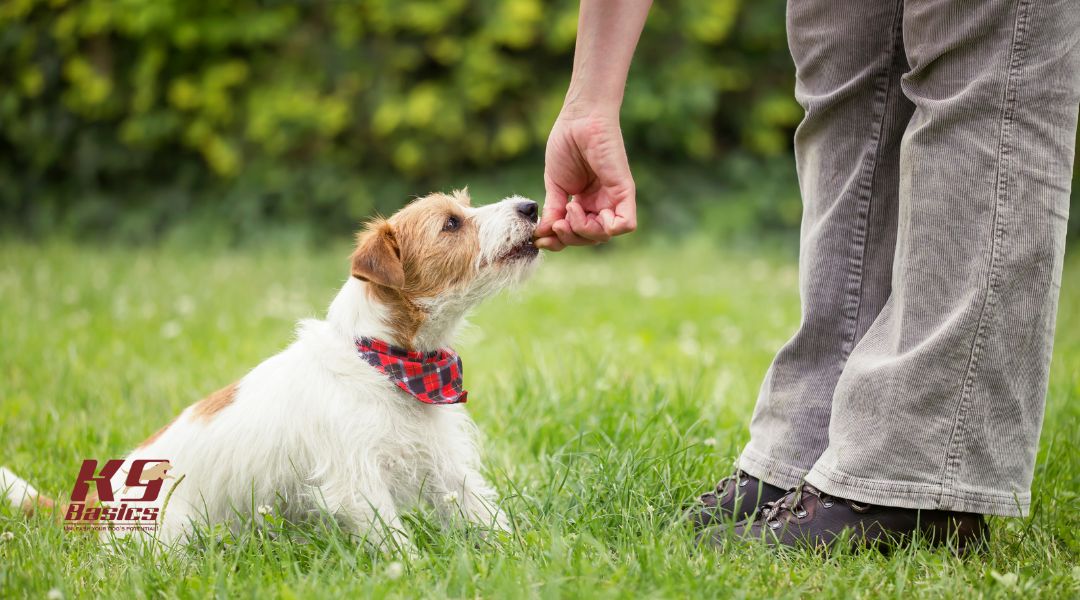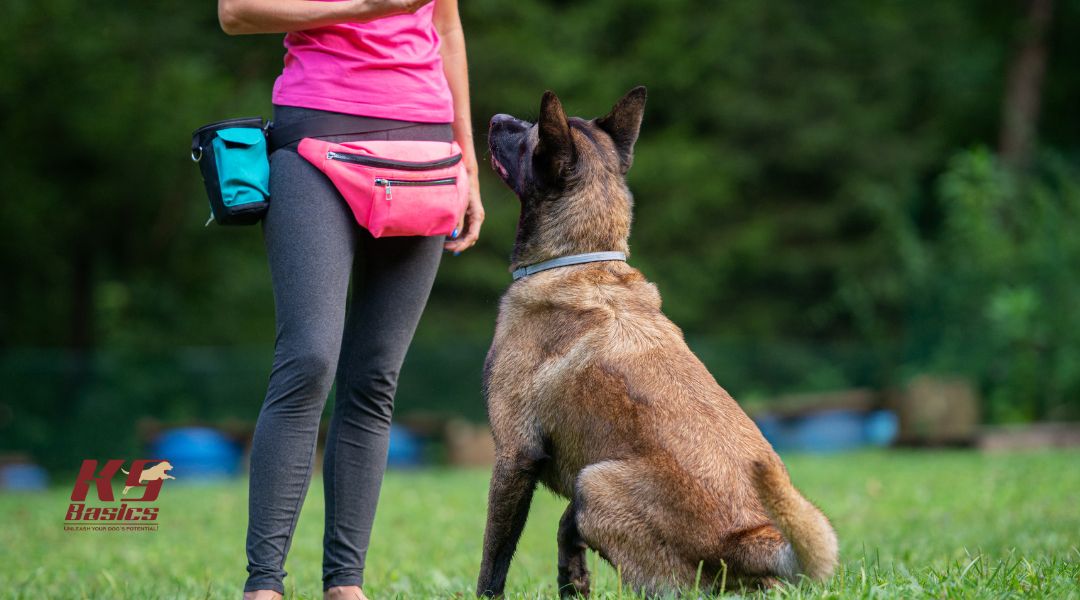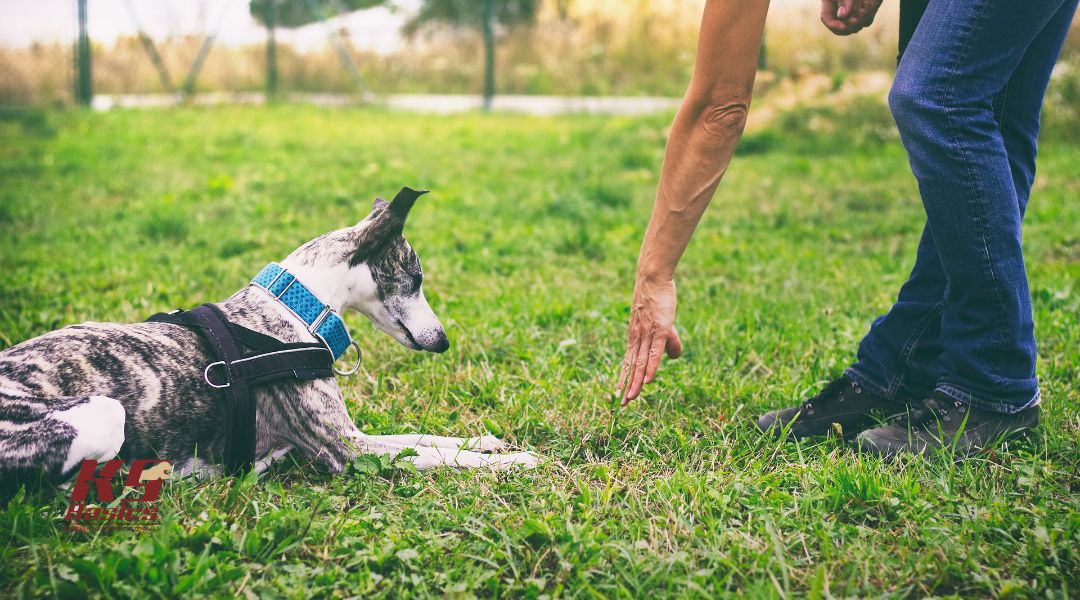Dogs thrive when they receive clear guidance, structure, and positive reinforcement. At K9 Basics, we believe in a balanced dog training approach that nurtures trust while promoting well-mannered behavior.
Our method combines reward-based motivation with gentle corrections, ensuring dogs understand expectations while feeling safe and supported.
Whether you’re addressing behavioral challenges or refining basic commands, our training techniques empower both dogs and their owners to communicate effectively.
The Balanced Approach vs. Force-Free Training
Dog training methods often fall into two primary categories: balanced and force-free. While both aim to foster well-behaved, confident dogs, they differ in execution and philosophy.
Balanced training integrates both positive reinforcement (rewards, praise, treats) and corrections (gentle redirection or consequences) to guide a dog’s behavior. This approach ensures that dogs learn desirable behaviors through encouragement and understand boundaries through fair, non-harmful corrections.
Force-free training, on the other hand, relies solely on positive reinforcement. While this method can effectively teach commands and tricks, it often falls short in addressing unwanted behaviors like excessive barking, leash pulling, aggression, or jumping. Without any correction, dogs may struggle to understand undesirable behaviors, leading to inconsistent obedience.
At K9 Basics, we believe in balanced training because it provides clarity, structure, and the ability to correct behaviors effectively while maintaining trust and a positive relationship with your dog.

Balanced Training Mirrors Parenting
Raising a well-mannered dog is much like raising a child—it requires a healthy balance of rewards and discipline. Just as parents guide children with both encouragement and consequences, balanced training ensures that dogs receive fair corrections alongside praise and rewards.
Imagine a child who is only rewarded for good behavior but never corrected for misbehaving. They may struggle with boundaries, respect, and discipline. Similarly, dogs who receive only positive reinforcement may become confused when certain behaviors are ignored rather than corrected.
Balanced training mirrors effective parenting in several ways:
- Clear expectations: Dogs learn what is acceptable and what isn’t, just as children do.
- Consistency & fairness: A balance of praise and correction ensures the dog understands cause and effect.
- Building confidence: Dogs gain self-assurance when they know their role and boundaries within the family.
By using balanced methods, dog owners provide their pets with a structured environment where they feel secure, leading to a well-behaved, happy, and confident companion.
The Misconception of Force-Free Training
Force-free training is often marketed as the most humane method of dog training, but it comes with significant misconceptions. One of the biggest misunderstandings is that any form of correction is harmful or cruel.
In reality, balanced training does not use harsh punishments or fear-based techniques. Instead, it involves gentle, fair corrections to stop unwanted behaviors while still using rewards to reinforce positive actions.
Here are common misconceptions about force-free training:
- “Corrections are cruel.”
In truth, a properly timed, non-harmful correction (like a leash redirection or a firm “no”) provides clear guidance, just as a parent might redirect a child away from danger. - “Ignoring bad behavior makes it go away.”
Dogs need clear communication—ignoring unwanted behaviors often reinforces those behaviors rather than their elimination. - “All dogs respond to positive reinforcement alone.”
While treats and praise work well for many commands, some behaviors—especially dangerous ones like aggression or running into the street—require firm correction to prevent harm.

The Four Quadrants of Balanced Dog Training
Balanced dog training is based on operant conditioning, a psychological framework that explains how animals (and humans) learn behaviors based on consequences.
This framework consists of four quadrants:
- Positive Reinforcement (Adding something pleasant to encourage behavior).
- Negative Reinforcement (Removing something unpleasant to encourage behavior).
- Positive Punishment (Adding something unpleasant to discourage behavior).
- Negative Punishment (Removing something pleasant to discourage behavior).
Unlike force-free training, which focuses solely on positive reinforcement, balanced training incorporates all four quadrants in a fair, humane, and structured way.
Just as a parent wouldn’t let a toddler stick their fingers into an electrical outlet, a responsible dog owner wouldn’t allow their dog to engage in unsafe or inappropriate behavior without correction.
A completely hands-off, let-the-dog-decide approach is unrealistic and can lead to behavioral problems. Dogs don’t naturally make the best decisions for themselves—they need clear guidance, structure, and boundaries to thrive. Balanced training ensures they understand what’s expected, leading to a well-mannered and happy companion.

6 Key Principles of Balanced Dog Training
Balanced dog training is rooted in structure, consistency, and fairness. It’s not about harsh corrections or permissive indulgence—it’s about clear communication and teaching dogs to make better choices in a way they understand.
Here are the core principles that make balanced training effective:
- Clarity & consistency: Dogs thrive on clear expectations. When they understand what is expected of them and receive consistent feedback, they learn faster and feel more secure.
- Positive reinforcement first: Rewarding good behavior is always the starting point. Treats, praise, and toys help reinforce desirable actions and build enthusiasm for learning.
- Fair & appropriate corrections: Corrections are used only when necessary and are always proportional to the behavior. The goal is not to intimidate but to guide.
- Tailored approach: Every dog is different. A balanced approach adapts to the individual dog’s temperament, breed, and learning style.
- Building trust & respect: Training should strengthen the relationship between the dog and owner, fostering mutual trust rather than fear or confusion.
- Providing structure & leadership: Dogs don’t instinctively make their best decisions. A structured environment helps them feel safe, confident, and well-behaved.
By incorporating both rewards and fair corrections, balanced training creates a well-rounded, obedient, and happy dog who understands boundaries and expectations.

Striking the Right Balance: Guidance Without Suppression
One of the most common misconceptions about balanced training is the belief that corrections suppress a dog’s instincts or personality. In-person balanced training enhances a dog’s ability to make better choices without diminishing their individuality.
Dogs are naturally playful, curious, and full of energy, but they also need guidance to know when and how to express these traits appropriately.
For example:
- A dog who loves to jump on people can still express excitement but should be taught to greet politely.
- A dog with a high prey drive doesn’t need to lose their instincts but should learn impulse control to avoid chasing small animals.
- A dog that barks excessively should not lose their natural guarding instincts but should learn to bark appropriately.
Balanced training ensures that dogs are not forced into submission but rather guided to develop self-control and better behavior. It’s about working with a dog’s instincts, not against them while fostering a relationship built on mutual respect and understanding.

Start Building a Stronger Bond With Your Dog Today!
At K9 Basics’ premier dog training facility, we believe in giving dog owners the tools and knowledge to communicate effectively with their dogs, ensuring they feel confident, well-mannered, and happy in any situation.
Ready to transform your household? Call us at (866) 592-2742 or, if you’re from New Jersey, Pennsylvania, Delaware, or New York, visit us at 131 Kenilworth Road, Marlton, NJ 08053, to learn more about our group training classes.
Also, browse our blog and social media for various topics about dogs and their lives with us!
